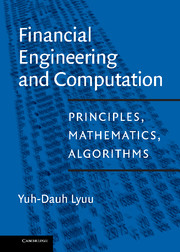Book contents
- Frontmatter
- Contents
- Preface
- Useful Abbreviations
- 1 Introduction
- 2 Analysis of Algorithms
- 3 Basic Financial Mathematics
- 4 Bond Price Volatility
- 5 Term Structure of Interest Rates
- 6 Fundamental Statistical Concepts
- 7 Option Basics
- 8 Arbitrage in Option Pricing
- 9 Option Pricing Models
- 10 Sensitivity Analysis of Options
- 11 Extensions of Options Theory
- 12 Forwards, Futures, Futures Options, Swaps
- 13 Stochastic Processes and Brownian Motion
- 14 Continuous-Time Financial Mathematics
- 15 Continuous-Time Derivatives Pricing
- 16 Hedging
- 17 Trees
- 18 Numerical Methods
- 19 Matrix Computation
- 20 Time Series Analysis
- 21 Interest Rate Derivative Securities
- 22 Term Structure Fitting
- 23 Introduction to Term Structure Modeling
- 24 Foundations of Term Structure Modeling
- 25 Equilibrium Term Structure Models
- 26 No-Arbitrage Term Structure Models
- 27 Fixed-Income Securities
- 28 Introduction to Mortgage-Backed Securities
- 29 Analysis of Mortgage-Backed Securities
- 30 Collateralized Mortgage Obligations
- 31 Modern Portfolio Theory
- 32 Software
- 33 Answers to Selected Exercises
- Bibliography
- Glossary of Useful Notations
- Index
21 - Interest Rate Derivative Securities
Published online by Cambridge University Press: 19 September 2009
- Frontmatter
- Contents
- Preface
- Useful Abbreviations
- 1 Introduction
- 2 Analysis of Algorithms
- 3 Basic Financial Mathematics
- 4 Bond Price Volatility
- 5 Term Structure of Interest Rates
- 6 Fundamental Statistical Concepts
- 7 Option Basics
- 8 Arbitrage in Option Pricing
- 9 Option Pricing Models
- 10 Sensitivity Analysis of Options
- 11 Extensions of Options Theory
- 12 Forwards, Futures, Futures Options, Swaps
- 13 Stochastic Processes and Brownian Motion
- 14 Continuous-Time Financial Mathematics
- 15 Continuous-Time Derivatives Pricing
- 16 Hedging
- 17 Trees
- 18 Numerical Methods
- 19 Matrix Computation
- 20 Time Series Analysis
- 21 Interest Rate Derivative Securities
- 22 Term Structure Fitting
- 23 Introduction to Term Structure Modeling
- 24 Foundations of Term Structure Modeling
- 25 Equilibrium Term Structure Models
- 26 No-Arbitrage Term Structure Models
- 27 Fixed-Income Securities
- 28 Introduction to Mortgage-Backed Securities
- 29 Analysis of Mortgage-Backed Securities
- 30 Collateralized Mortgage Obligations
- 31 Modern Portfolio Theory
- 32 Software
- 33 Answers to Selected Exercises
- Bibliography
- Glossary of Useful Notations
- Index
Summary
I never gamble.
J.P. Morgan, Sr. (1837–1913)Interest-rate-sensitive securities are securities whose payoff depends on the levels and/or evolution of interest rates. The interest rate derivatives market is enormous. The global notional principal of over-the-counter derivative contracts was an estimated U.S.$72 trillion as of the end of June 1998, of which 67% were interest rate instruments and 31% were forex instruments [51]. The use of such derivatives in portfolio risk management has made possible economical and efficient alteration of interest rate sensitivities [325]. Throughout this book, interest rate derivative securities exclude fixed-income securities with embedded options.
Interest Rate Futures and Forwards
An interest rate futures contract is a futures contract whose underlying asset depends solely on the level of interest rates. Figure 21.1 gives an idea of the diversity of interest rate futures.
Treasury Bill Futures
The first financial futures contract was based on a fixed-income instrument, the Government National Mortgage Association (GNMA or “Ginnie Mac”) mortgage-backed certificates whose trading began in 1972 at the CBT. The IMM of the CME followed 3 months later with futures contracts based on the 13-week T-bill [95].
The T-bill futures contract traded on the IMM is based on the 13-week (3-month) T-bill with a face value of $1 million. The seller of a T-bill futures contract agrees to deliver to the buyer at the delivery date a T-bill with 13 weeks remaining to maturity and a face value of $1 million. The T-bill delivered can be newly issued or seasoned. The futures price is the price at which theT-bill will be sold by the short and purchased by the buyer.
- Type
- Chapter
- Information
- Financial Engineering and ComputationPrinciples, Mathematics, Algorithms, pp. 295 - 320Publisher: Cambridge University PressPrint publication year: 2001



